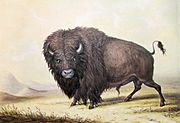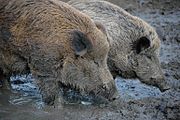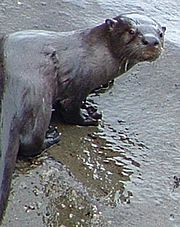List of mammals of West Virginia facts for kids
West Virginia is a special place that's home to 72 different kinds of wild mammals! Some of these animals are very rare, and four of them are even on the federal list of endangered species. These include the Virginia big-eared bat, the Indiana bat, the West Virginia northern flying squirrel, and the eastern cougar, which sadly is now extinct. It's important to keep an eye on other rare species in the state too.
Some mammals are doing really well, even with people around. For example, the opossum is found in more places now because of human activities. Animals that like farms and new habitats are also thriving. The coyote is spreading across the eastern United States and can now be found all over West Virginia.
If you want to see some of West Virginia's amazing native animals, you can visit the West Virginia State Wildlife Center. It's like a small zoo just for local wildlife!
Contents
Meet the Mammals of West Virginia
It's fun to know how likely you are to spot different animals in West Virginia. Here's what the letters mean:
| C | Common | You can often see this animal in places where it lives. |
| U | Uncommon | It's harder to see this animal because it might hide a lot or live in very specific places. |
| R | Rare | This animal is not often found, even in good habitats. |
| RI | Reintroduced | This animal used to live here, disappeared, and then people brought it back. |
| I | Introduced | This animal is not originally from West Virginia; people brought it here. |
| X | Extirpated | This animal no longer lives in West Virginia. |
Scientists also use special terms to describe how much danger an animal is in globally. Some West Virginia mammals are:
- Critically Endangered: Very, very close to disappearing forever.
- Endangered: At high risk of disappearing.
- Vulnerable: At risk of becoming endangered.
- Near-threatened: Might become threatened in the future.
Opossums
- Virginia opossum (Didelphis virginiana) C
- This is the only marsupial (pouched mammal) found in North America!
Shrews, Moles, and Relatives
- Northern short-tailed shrew (Blarina brevicauda) C
- Shrews are tiny, mouse-like animals that are very active.
- Star-nosed mole (Condylura cristata) U
- This mole has a unique nose with 22 pink, fleshy tentacles!
Bats
Bats are amazing flying mammals! Many bat species in West Virginia are facing challenges.
- Virginia big-eared bat (Corynorhinus townsendii) R
- This bat has huge ears and is federally endangered.
- Indiana bat (Myotis sodalis) R
- Another federally endangered bat, often found in caves during winter.
- Little brown bat (Myotis lucifugus) C
- Once very common, but now facing threats from a disease called White-nose Syndrome.
Rodents
West Virginia has many types of rodents, from tiny mice to large beavers.
- Northern flying squirrel (Glaucomys sabrinus) R
- This squirrel doesn't actually fly, but glides between trees! The West Virginia subspecies is endangered.
- North American beaver (Castor canadensis) C, RI
- Beavers are expert builders, known for their dams and lodges. They were reintroduced to the state.
- Woodland vole (Microtus pinetorum) C
- Voles are small rodents that live in burrows underground.
- North American porcupine (Erethizon dorsatum) R
- These animals are famous for their sharp quills, which they use for defense.
Rabbits and Hares
- Snowshoe hare (Lepus americanus) U
- These hares change their fur color from brown in summer to white in winter, helping them blend in with the snow.
- Eastern cottontail (Sylvilagus floridanus) C
- A common rabbit found in many different habitats.
Carnivores (Meat-Eaters)
- Coyote (Canis latrans) C
- Coyotes are adaptable canids that have expanded their range across the state.
- American black bear (Ursus americanus) U
- The black bear has been West Virginia's state animal since 1973!
- North American river otter (Lontra canadensis) RI
- These playful animals were reintroduced and are now thriving in West Virginia's rivers.
- Bobcat (Lynx rufus) U
- Bobcats are wild cats with short, "bobbed" tails.
Even-Toed Ungulates (Hoofed Animals)
- White-tailed deer (Odocoileus virginianus) RI
- These deer are very common now, but they almost disappeared from the state.
- Elk (Cervus canadensis) RI
- Elk are large deer that are being reintroduced to West Virginia.
Animals Not Originally from West Virginia
Some animals living in West Virginia today were brought here by humans, either on purpose or by accident. These are called introduced species.
Wild Boar
The European wild boar (Sus scrofa scrofa) was brought to southeastern West Virginia in 1971 for hunting. You can find them in counties like Boone, Logan, Raleigh, and Wyoming. However, their numbers have been going down since the late 1990s. This is mainly because they've lost some of their habitat and have to compete with native black bears and white-tailed deer for food and space.
Other introduced animals include the House mouse (Mus musculus), Brown rat (Rattus norvegicus), and Black rat (Rattus rattus). These small rodents arrived in North America with European settlers a long time ago.
Animals That Disappeared (Extirpated)
Extirpated means an animal no longer lives in a specific area, even if it still exists elsewhere in the world. West Virginia has seen several animals disappear from its wild lands.
Eastern Timber Wolf
The eastern timber wolf (Canis lycaon) used to live all over West Virginia before settlers arrived. People even paid money for wolf "scalps" until the late 1890s. The last known wolf was killed in Randolph County in 1900.
Red Wolf
The red wolf (Canis rufus) was also once native to West Virginia but disappeared not long after its relative, the eastern wolf.
North American Cougar
The North American cougar (Puma concolor couguar), also known as a mountain lion or panther, was thought to be completely gone from West Virginia by 1900. The last official record of cougar tracks was in 1936. In 2011, the U.S. Fish and Wildlife Service officially declared the eastern cougar extirpated from the region.
Bison

The American bison (Bison bison), sometimes called buffalo, used to roam in large herds all over West Virginia. Many places in the state are named after them, like Buffalo Creek and the town of Buffalo. Early explorers saw huge groups of bison, especially along the Ohio and Kanawha Rivers. These herds created paths, which later became trails for Native Americans and then roads for European settlers. Sadly, many bison were killed for sport, and by the early 1800s, they were rarely seen. The last known bison in West Virginia was killed in 1825.
Animals Brought Back (Reintroduced)
Reintroduction is when people bring animals back to an area where they used to live but had disappeared. West Virginia has had some great success stories bringing back native species.
White-Tailed Deer
The white-tailed deer (Odocoileus virginianus virginianus) used to live everywhere in West Virginia. But too much hunting almost made them disappear by 1890. Thanks to new hunting rules, game refuges, and restocking efforts, the deer population slowly came back. In the 1930s, deer were brought from Michigan and released in places like the Monongahela National Forest. Today, these deer are very common all over the state!
Beaver
North American beaver (Castor canadensis) were almost completely gone from West Virginia by 1825 because of trapping. Their comeback started in 1933 when a few beavers were released in Randolph County. More were released later, and now beavers are common again.
Fisher
The fisher (Pekania pennanti) is a type of weasel. They were rare in West Virginia by 1900 and thought to be gone by 1912. But in 1969, 23 fishers were brought from New Hampshire and released in the Monongahela National Forest. Now, they are back in the state.
River Otter
The North American river otter (Lontra canadensis) is a native animal that faced problems due to losing its habitat and too much trapping. The last otter was reported in Tucker County in 1954. To help them, 245 river otters were released into 14 major river systems in West Virginia between 1984 and 1997. Now, river otters are successfully living in the state again!
Elk

Large groups of eastern elk (Cervus canadensis canadensis) didn't survive long after European settlers arrived in West Virginia. The last elk in the region was likely killed around 1843, and the subspecies was completely gone by 1880.
However, the neighboring state of Kentucky successfully brought back Rocky Mountain elk (C. c. nelsoni) in 1997. By 2009, their population grew so much that elk started moving into western Virginia and southwestern West Virginia. In 2011, the West Virginia Division of Natural Resources started a plan to help elk return to the state naturally. This reintroduction is still happening today!
Ancient Mammals of West Virginia (Ice Age)
Long, long ago, during the Ice Age (Pleistocene period), West Virginia was home to some truly giant and amazing animals, called megafauna. Their fossils have been found in caves and other places around the state.
Some of these incredible creatures included:
- Jefferson's ground sloth (Megalonyx jeffersonii)
- Mammoths (Mammuthus spp.), including the huge woolly mammoth
- American mastodon (Mammut americanum)
- Saber-toothed cat (Smilodon spp.)
- Dire wolf (Aenocyon dirus)
- Giant bear (Arctodus pristinus)
There were also smaller ancient mammals like the Pleistocene armadillo (Dasypus bellus) and a type of vampire bat (Desmodus spp.). These fossils help us understand what West Virginia was like thousands of years ago!
See also
- Lists of mammals by region
- West Virginia State Wildlife Center, a small zoo featuring native West Virginia animals
- Fauna of West Virginia
- List of West Virginia wildlife management areas



